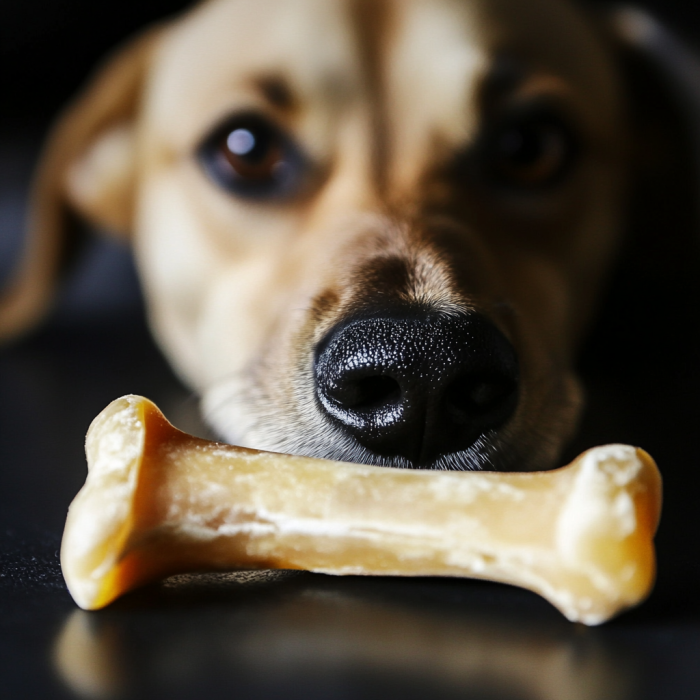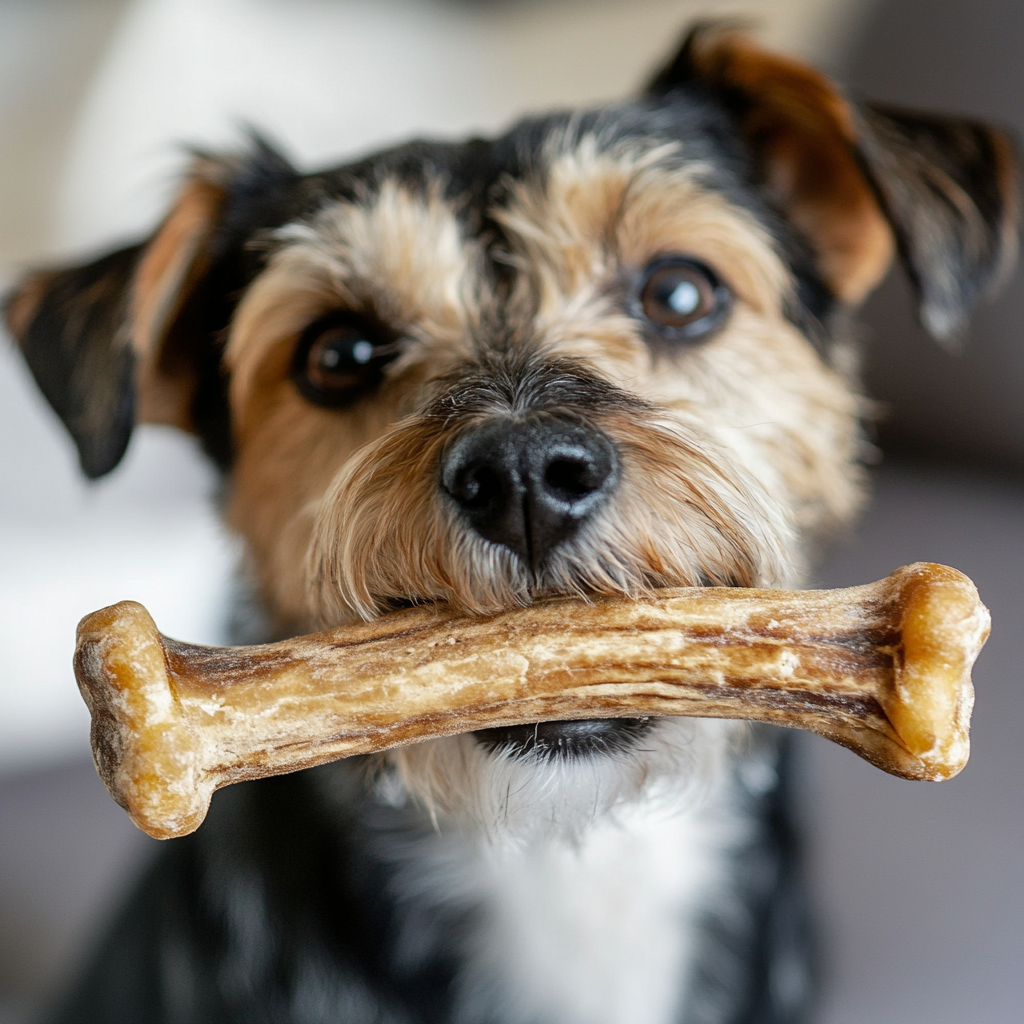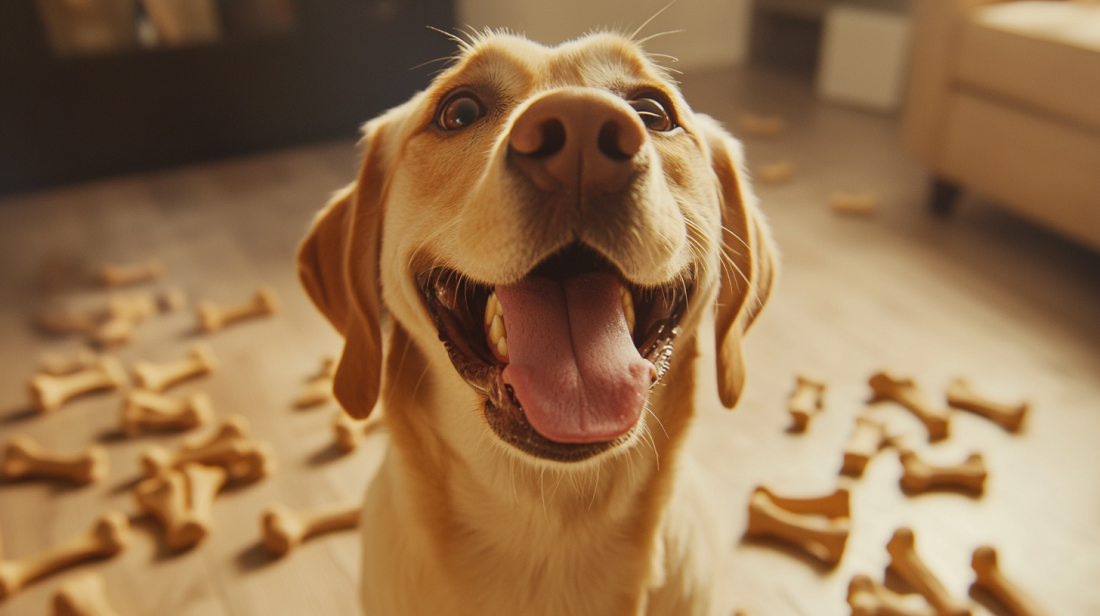Discover the 6 powerful types of dog bones for healthy chewing habits in your canine companion. Our expert guide helps you choose the safest and most effective options for dental health.
Table of Contents


Introduction: Why Dog Bones Matter for Your Canine’s Health
Every dog owner knows that distinctive sound – the enthusiastic gnawing of their four-legged friend working on a dog bone. But dog bones aren’t just about keeping your pet entertained; they’re essential tools for dental health, mental stimulation, and overall well-being. Finding the right dog bones for your furry companion can mean the difference between healthy chewing habits and potential health risks.
In this comprehensive guide, we’ll explore the six most powerful types of dog bones that promote healthy chewing behaviors while supporting your dog’s physical and mental health. From durable options for aggressive chewers to gentler alternatives for seniors, we’ll help you navigate the world of dog bones to make informed choices for your beloved pet.
Understanding the Importance of Chewing for Dogs
Before diving into specific types of dog bones, it’s crucial to understand why chewing is such a fundamental behavior for our canine companions.
Natural Instinct and Evolutionary Purpose
Dogs are descendants of wolves, and in the wild, chewing serves multiple purposes:
- Dental maintenance: Wild canines clean their teeth by gnawing on bones and tough materials
- Nutrient extraction: Breaking down bones provides valuable nutrients like calcium
- Jaw strength development: Regular chewing exercises and strengthens jaw muscles
Domesticated dogs retain these instincts, which is why providing appropriate dog bones is essential for their overall health and satisfaction.
Benefits of Appropriate Chewing
When dogs have access to proper dog bones, they experience numerous health benefits:
- Dental health maintenance: Reduces plaque and tartar buildup
- Mental stimulation: Alleviates boredom and prevents destructive behaviors
- Anxiety reduction: Acts as a stress-relieving activity
- Jaw muscle development: Strengthens facial and jaw muscles
- Gum health: Massages gums and improves blood circulation
According to a 2023 survey by the American Veterinary Dental Association, dogs who regularly chew on appropriate dental bones experience up to 57% less tartar buildup compared to those without regular chewing opportunities.
Risks of Inappropriate Chewing Materials
While chewing is natural and beneficial, not all dog bones are created equal. Inappropriate chewing materials can lead to:
| Risk | Potential Consequences | Prevention |
| Tooth fractures | Painful injuries, costly dental procedures | Choose appropriately sized and textured bones |
| Gastrointestinal blockages | Emergency surgery, potential fatality | Avoid bones that splinter or break into large chunks |
| Choking hazards | Emergency situations, requires immediate attention | Supervise chewing sessions, select appropriate size |
| Mouth injuries | Cuts, abrasions, infections | Inspect bones for sharp edges, replace worn items |
| Nutritional imbalances | Digestive issues, weight management problems | Balance chew treats with regular diet |
Now that we understand the importance of appropriate chewing materials, let’s explore the six most beneficial types of dog bones available today.
Type 1: Raw Meaty Bones
Raw meaty bones (RMBs) represent one of the most natural chewing options available for dogs, closely mimicking what their wild ancestors would consume.
What Are Raw Meaty Bones?
Raw meaty bones are uncooked animal bones with attached meat and connective tissue. These include:
- Chicken necks, backs, and wings
- Turkey necks
- Lamb ribs and necks
- Beef knucklebones
- Oxtails
Unlike cooked bones, which can splinter and pose significant health risks, raw bones maintain their structural integrity while being soft enough for dogs to safely consume.
Benefits of Raw Meaty Bones
Raw meaty bones offer several unique advantages:
- Complete dental workout: The combination of meat, cartilage, and bone provides comprehensive cleaning
- Nutritional value: Delivers natural calcium, phosphorus, and other nutrients
- Extended chew time: Keeps dogs engaged longer than many commercial alternatives
- Satisfies primal instincts: Closely resembles natural prey items
According to Dr. Karen Becker, DVM, “Raw meaty bones are nature’s toothbrush for dogs. They require dogs to use their entire mouth – front teeth to grasp and tear, and back teeth to chew and crush – providing a complete oral workout.”
Safety Considerations
While raw meaty bones are beneficial, they require proper handling:
- Size appropriately: Choose bones large enough that your dog cannot swallow them whole
- Supervise: Always monitor your dog while they enjoy raw bones
- Fresh sourcing: Purchase from reputable suppliers to minimize pathogen risks
- Proper storage: Keep refrigerated and discard after a few days
- Individual tolerance: Start slowly, as some dogs may experience digestive adjustments
Note: Raw meaty bones are not recommended for dogs with certain health conditions, including pancreatitis, compromised immune systems, or those on specific medications. Always consult your veterinarian before introducing raw bones to your dog’s regimen.
Type 2: Recreational Bones
Recreational bones serve primarily as entertainment rather than consumption, providing hours of chewing satisfaction for dedicated gnawers.
What Are Recreational Bones?
Recreational bones are typically larger, denser bones not intended to be fully consumed. Common examples include:
- Beef femur bones (marrow bones)
- Knucklebones
- Large soup bones
These substantial bones typically come from larger animals and feature a hard, dense structure that withstands prolonged chewing sessions.
Benefits of Recreational Bones
These robust dog bones offer distinct advantages:
- Exceptional durability: Ideal for powerful, persistent chewers
- Mental stimulation: Engaging activity that occupies dogs for extended periods
- Dental abrasion: The hard surface helps scrape away tartar
- Marrow access: Many contain nutrient-rich marrow that dogs find irresistible
- Cost-effective: Long-lasting compared to many commercial alternatives
A 2024 study in the Journal of Veterinary Behavior found that dogs provided with appropriate recreational bones spent an average of 43 minutes per session engaged in focused chewing activity, significantly reducing destructive behaviors in the home.
Potential Drawbacks
Despite their benefits, recreational bones come with some considerations:
- Tooth damage risk: Extremely hard bones may cause tooth fractures in aggressive chewers
- Resource guarding: The high value may trigger territorial behavior in some dogs
- Messiness: Marrow and residue can stain carpets and furniture
- Limited consumption: Minimal nutritional benefit as they’re not fully consumed
- Size selection crucial: Inappropriately sized bones pose choking or obstruction risks
Dr. Marty Becker, DVM, recommends, “If you can’t make a fingernail impression in the bone, it may be too hard for your dog’s teeth. The ideal recreational bone should be firm but have some slight give.”
Best Practices for Recreational Bones
To maximize benefits while minimizing risks:
- Refrigerate between chewing sessions
- Limit sessions to 15-20 minutes to prevent obsessive behavior
- Replace when the bone develops cracks or sharp edges
- Consider freezing (especially marrow bones) for an extra challenge
- Designate a specific “bone zone” with washable surfaces or towels
Type 3: Dental Chew Bones
Designed specifically for oral health, dental chew bones combine effective plaque removal with palatability.
What Are Dental Chew Bones?
Dental chew bones are commercially manufactured products formulated to clean teeth while being safely digestible. They typically feature:
- Textured surfaces for mechanical cleaning
- Enzymatic additives that break down plaque
- Ingredients that freshen breath
- Shapes designed to reach all areas of the mouth
Popular brands include Greenies, Dentastix, OraVet Dental Hygiene Chews, and Whimzees.
Benefits of Dental Chew Bones
These specialized dog bones offer several advantages:
- Scientifically formulated: Designed specifically for dental health
- Controlled ingredients: Known composition, unlike natural products
- Consistent texture: Engineered to provide optimal cleaning action
- Digestible: Minimizes obstruction risks
- Veterinary endorsement: Many carry the Veterinary Oral Health Council (VOHC) seal of approval
A clinical study published in the Journal of Veterinary Dentistry found that daily use of approved dental chews reduced plaque by up to 45% and tartar by up to 33% when used regularly as part of a comprehensive dental care program.
Comparing Top Dental Chew Options
| Brand | VOHC Approved | Primary Ingredients | Best For | Average Cost |
| Greenies | Yes | Wheat flour, glycerin, gelatin | All-around dental care | $35-45/month |
| Dentastix | Yes | Rice flour, wheat starch, calcium carbonate | Budget-conscious owners | $15-25/month |
| OraVet | Yes | Corn starch, glycerin, dried yeast | Persistent plaque issues | $25-35/month |
| Whimzees | Yes | Potato starch, glycerin, yeast | Sensitive stomachs | $20-30/month |
| C.E.T. Veggiedent | Yes | Corn starch, glycerin, rice powder | Vegetarian option | $20-30/month |
Limitations and Considerations
While convenient and effective, dental chews have some drawbacks:
- Caloric content: Can contribute to weight gain if not accounted for in daily feeding
- Allergic reactions: Some dogs may be sensitive to specific ingredients
- Rapid consumption: Fast chewers may swallow pieces that are too large
- Cost factor: Regular use represents an ongoing expense
- Not a complete solution: Should complement, not replace, regular dental care
Dr. Jan Bellows, board-certified veterinary dentist, notes, “Dental chews are an excellent supplement to home care but should never replace brushing. Think of them as mouthwash, not toothbrushing.”
Type 4: Synthetic and Nylon Bones
For dogs who need extremely durable chewing options, synthetic and nylon bones offer long-lasting resilience.
What Are Synthetic Bones?
Synthetic bones are manufactured from non-edible materials designed specifically for durability and dental benefits. Common varieties include:
- Nylabone products
- Benebones
- Goughnut chews
- Kong Extreme rubber toys (bone-shaped varieties)
These dog bones are crafted from materials like nylon, rubber, or proprietary polymers engineered to withstand powerful chewing forces.
Benefits of Synthetic Bones
Synthetic chewing options offer unique advantages:
- Exceptional durability: Often outlast natural alternatives by months or years
- Sanitizable: Can be washed in dishwashers or with soap and water
- Non-nutritive: Don’t add calories to the diet
- Versatility: Available in various sizes, shapes, and textures
- Flavoring: Many incorporate appealing flavors without perishability
According to a 2023 consumer survey by Pet Product News, synthetic bones were rated the most cost-effective long-term chewing solution, with 72% of power-chewer owners reporting satisfaction with durability.
Best Applications for Synthetic Bones
These products are particularly valuable for:
- Aggressive chewers: Dogs who quickly destroy natural alternatives
- Unsupervised chewing: Safer when direct observation isn’t possible
- Dental maintenance: Textured varieties help clean teeth
- Boredom prevention: Long-lasting entertainment
- Dogs with dietary restrictions: No interference with specialized diets
Safety Considerations
Despite their durability, synthetic bones require some precautions:
- Regular inspection: Check for fragments or damage that could create sharp edges
- Appropriate sizing: Should be large enough to prevent swallowing
- Material quality: Choose products from reputable manufacturers with safety testing
- Replacement schedule: No synthetic bone lasts forever
- Individual preferences: Some dogs find artificial materials less appealing
Veterinary behaviorist Dr. Sophia Yin recommended, “The general rule is that if you can’t make a dent in it with your fingernail, it’s likely too hard for your dog’s teeth. Even with synthetic bones, there should be some minimal give to the material.”
Type 5: Edible Processed Bones
Edible processed bones offer a middle ground between treats and chewing tools, providing both entertainment and consumption.
What Are Edible Processed Bones?
These dog bones are manufactured specifically for consumption while still providing adequate chewing time. Common varieties include:
- Pressed rawhide alternatives
- Beefhide rolls
- Compressed vegetable starch bones
- Puffed collagen chews
- Himalayan yak cheese chews
Unlike traditional rawhide (which has fallen out of favor due to safety concerns), modern edible bones are designed for safer digestion.
Benefits of Edible Processed Bones
These products offer a balance of features:
- Moderate durability: Last longer than treats but eventually consumed
- Digestibility: Designed to break down safely in digestive system
- Varied textures: Different options for different chewing styles
- Nutrient fortification: Many contain added vitamins and minerals
- Palatability: Highly appealing to most dogs
A study in the International Journal of Applied Research in Veterinary Medicine found that dogs provided with digestible chews spent 15-27 minutes engaged in active chewing, an optimal duration for stress reduction without obsessive behavior.
Comparing Popular Edible Bone Options
| Type | Composition | Durability | Best For | Special Considerations |
| Earth Animal No-Hide | Collagen, brown rice flour | Moderate | Dogs with rawhide sensitivities | More expensive than alternatives |
| Whimzees Brushzees | Potato starch, glycerin | Low-moderate | Dental focus | Fully vegetarian |
| Himalayan Dog Chew | Yak milk, cow milk, lime juice | High | Power chewers | Hard but slowly softens |
| SmartBones | Chicken, vegetables, cornstarch | Low | Gentle chewers | Highly digestible |
| Bully Sticks | Beef muscle | Moderate | Protein preference | Strong odor, calorie-dense |
Potential Concerns
While safer than traditional options, processed edible bones warrant some caution:
- Caloric content: Can be surprisingly high, impacting weight management
- Consumption rate: Heavy chewers may consume too quickly
- Quality variation: Significant differences between budget and premium brands
- Allergenic ingredients: May contain common allergens like chicken or beef
- Staining potential: Some varieties may leave residue on carpets or furniture
Veterinary nutritionist Dr. Lisa Weeth advises, “Always factor edible chews into your dog’s daily caloric intake. A medium bully stick can contain up to 100 calories, which represents a significant percentage of a small dog’s daily needs.”
Type 6: Therapeutic Frozen Bones
An innovative approach to chewing combines dental benefits with soothing properties for specific health needs.
What Are Therapeutic Frozen Bones?
Therapeutic frozen bones are either commercially manufactured or homemade chew options that capitalize on the benefits of cold temperatures. These include:
- Frozen rubber bones filled with broth or yogurt
- Commercially prepared frozen dental chews
- Frozen wet food or pureed vegetables in bone-shaped molds
- Specialized teething products for puppies
These unique dog bones combine the benefits of temperature therapy with the mechanical action of chewing.
Benefits of Therapeutic Frozen Bones
These specialized options offer unique advantages:
- Gum soothing: Particularly beneficial for puppies and senior dogs
- Inflammation reduction: Cold helps reduce swelling in irritated gums
- Extended chew time: Freezing increases duration of engagement
- Versatility: Can be customized to individual preferences or dietary needs
- Cost-effectiveness: Many options can be created at home
Veterinary dental specialist Dr. Brook Niemiec notes, “Frozen chews are particularly valuable for puppies during teething, post-dental procedure recovery, and dogs with mild gum inflammation who need both the benefits of chewing and the soothing properties of cold.”
Best Applications for Frozen Bones
These specialized chews are particularly valuable for:
- Teething puppies: Numbs gum discomfort while providing appropriate chewing outlet
- Post-dental procedure recovery: Gentle option during healing
- Senior dogs with sensitive teeth: Softer than traditional bones
- Summer enrichment: Cooling effect during hot weather
- Dogs on restricted diets: Can be customized to accommodate allergies or sensitivities
DIY Therapeutic Frozen Bone Recipes
Creating therapeutic frozen bones at home allows for customization while being budget-friendly:
Basic Broth Bones
- Fill bone-shaped silicone molds with low-sodium chicken or beef broth
- Add a sprinkle of parsley for breath freshening
- Freeze for 4-6 hours
Cooling Yogurt Chews
- Mix plain, unsweetened yogurt with a tablespoon of pumpkin puree
- Pour into ice cube trays or bone molds
- Freeze overnight
Vegetable-Enriched Frozen Bones
- Blend cooked sweet potato with a small amount of water
- Add finely chopped spinach and a teaspoon of coconut oil
- Pour into molds and freeze until solid
Storage and Safety
For optimal results with therapeutic frozen bones:
- Store in airtight containers to prevent freezer burn
- Prepare fresh batches every 2-3 weeks
- Serve on washable surfaces or in designated areas
- Monitor for mess as these tend to be drippy as they thaw
- Account for the nutritional content in daily feeding calculations
Choosing the Right Dog Bones: Factors to Consider
With six powerful types of dog bones available, selecting the right option depends on your dog’s specific needs and characteristics.
Age and Life Stage Considerations
Different life stages call for different chewing solutions:
Puppies (Under 1 Year)
- Softer materials to accommodate developing teeth
- Appropriately sized for smaller jaws
- Teething-specific options during months 3-7
- Emphasis on dental development and appropriate chewing habits
Adult Dogs (1-7 Years)
- Durability matched to chewing intensity
- Dental health focus
- Mental stimulation properties
- Size and power-appropriate selections
Senior Dogs (8+ Years)
- Gentler materials for potentially sensitive teeth
- Dental maintenance to prevent age-related issues
- Appropriate for any reduced jaw strength
- Consideration of dental condition (missing teeth, prior dental work)
Chewing Style Assessment
Understanding your dog’s chewing personality helps narrow options:
| Chewing Style | Characteristics | Best Bone Types | Avoid |
| Inhaler | Attempts to swallow items quickly | Oversized recreational bones, supervised raw bones | Small edible bones, dental chews |
| Destroyer | Aggressively breaks items apart | Synthetic bones, large raw meaty bones | Processed edible bones |
| Nibbler | Gently works on items over time | Dental chews, edible processed bones | Hard synthetic bones |
| Casual Chewer | Shows periodic interest | Variety pack of different types | Most expensive options |
| Power Chewer | Relentless, dedicated gnawing | Nylabone Durachew, beef femurs, rubber toys | Easily destroyed options |
Health and Dietary Restrictions
Medical conditions may influence appropriate bone selection:
- Food allergies: Choose limited ingredient or alternative protein options
- Dental disease: Softer materials for compromised teeth
- Pancreatitis: Avoid high-fat options like marrow bones
- Weight management: Calculate calories from edible bones into daily intake
- Gastrointestinal sensitivity: Introduce new chewing materials gradually
Veterinary nutritionist Dr. Cailin Heinze recommends, “Always consider your dog’s complete diet when introducing chewing items. Edible chews should comprise no more than 10% of your dog’s daily caloric intake.”
Lifestyle Integration
Practical considerations also influence the best choice:
- Supervision availability: Some bones require more monitoring than others
- Indoor vs. outdoor dogs: Messier options may work better for outdoor spaces
- Multi-dog households: Consider resource guarding tendencies
- Budget constraints: Balance initial cost with longevity
- Storage capacity: Some options require refrigeration or freezer space
Safety Guidelines: Maximizing Benefits While Minimizing Risks
Regardless of which dog bones you select, following these universal safety practices helps ensure a positive experience:
General Safety Rules
- Match size to dog: Bones should be larger than what could be swallowed whole
- Supervise initial use: Monitor how your dog interacts with any new chewing item
- Establish a “bone routine”: Consistent timing reduces resource guarding
- Regular inspection: Check for damage, splintering, or concerning wear
- Clean regularly: Wash non-edible bones with mild soap and water
- Replace when compromised: Discard bones with cracks, chips, or sharp edges
- Limit sessions: 15-30 minutes is typically sufficient for most dogs
- One at a time: Offer only one bone or chew per session
- Fresh water access: Always provide water during chewing sessions
- Storage safety: Keep bones out of reach between supervised sessions
Warning Signs to Watch For
Be alert for these potential issues:
- Broken teeth: Indicates the bone is too hard
- Bleeding gums: May suggest sharp edges or excessive pressure
- Choking: Requires immediate intervention
- Guarding behavior: Growling or aggression around bones
- Gastrointestinal upset: Vomiting or diarrhea after chewing sessions
- Scratched gums or mouth: Indicates potential sharp edges
- Obsessive behavior: Unhealthy fixation on chewing
According to the American Veterinary Medical Association, “The best way to minimize risks associated with chewing is through appropriate selection, proper supervision, and knowing your individual dog’s chewing habits and tendencies.”
FAQ: Common Questions About Dog Bones
Are antlers safe for dogs to chew on?
Antlers are extremely hard and pose a significant risk of tooth fractures. While popular, many veterinary dentists advise against them, especially for aggressive chewers. If you do offer antlers, choose split varieties (cut lengthwise) rather than whole antlers, and always supervise closely.
What’s the difference between raw bones and smoked bones?
Raw bones maintain their natural flexibility and moisture content, making them less likely to splinter. Smoked or cooked bones undergo processes that make them more brittle and dangerous, significantly increasing splintering risk. Veterinary consensus strongly recommends against giving dogs any cooked bones.
How often should I give my dog bones to chew?
This depends on your dog’s individual needs and the type of bone. For dental chews, daily use may be appropriate as part of an oral health routine. For recreational bones, 2-3 times weekly is typically sufficient. Always follow product-specific guidelines and adjust based on your dog’s response.
Can small dogs safely enjoy bones?
Yes, but size-appropriate selection is crucial. Small breeds benefit from specially sized options that allow proper chewing without presenting choking hazards. Avoid bones that are too small to prevent accidental swallowing. For toy breeds, supervised chewing is particularly important.
What should I do if my dog swallows a large piece of bone?
Monitor your dog closely for signs of distress, difficulty breathing, abdominal pain, or changes in appetite or bowel movements. Contact your veterinarian immediately if you observe concerning symptoms. In some cases, X-rays may be necessary to determine if intervention is required.
Are rawhide bones safe for dogs?
Traditional rawhide presents several concerns including chemical processing, potential choking hazards, and digestibility issues. Modern rawhide alternatives made from digestible ingredients are generally considered safer options. If using traditional rawhide, always choose large, high-quality products and supervise closely.
How can I tell if a bone is too hard for my dog?
Apply the “fingernail test” – if you cannot make a slight indentation with your fingernail, the bone may be too hard for your dog’s teeth. Another indicator is your dog’s behavior; if they lose interest quickly, the bone may be uncomfortably hard.
Should I refrigerate my dog’s bones between uses?
For raw meaty bones and other perishable options, refrigeration is essential. Synthetic bones can be washed and stored at room temperature. Follow manufacturer guidelines for commercial products, and when in doubt, refrigerate natural products to prevent bacterial growth.
Supporting Your Dog’s Chewing Needs: A Holistic Approach
While appropriate dog bones form a critical component of your pet’s chewing regimen, a comprehensive approach includes several complementary strategies:
Complete Dental Care Program
Bones and chews work best as part of a complete oral health routine:
- Regular veterinary dental check-ups (annually for most dogs)
- Home tooth brushing with dog-specific toothpaste (ideally daily)
- Professional dental cleanings when recommended
- Water additives or dental gels for plaque control
- Dental-friendly diet choices
Environmental Enrichment
Support appropriate chewing by addressing underlying needs:
- Regular physical exercise appropriate to breed and age
- Mental stimulation through training and puzzle toys
- Consistent schedule to reduce anxiety-related chewing
- Multiple appropriate chew options to prevent boredom
- Positive reinforcement for choosing appropriate items
Chewing Behavior Modification
For dogs with problematic chewing habits:
- Ensure adequate exercise before leaving dogs alone
- Use taste deterrents on inappropriate items
- Provide clear boundaries about acceptable chewing items
- Consider separation anxiety if destructive chewing occurs only when alone
- Consult a professional trainer or behaviorist for persistent issues
Call to Action
Finding the perfect dog bones for your canine companion is an ongoing journey of discovery. As your dog’s needs, preferences, and health status evolve, so too should your approach to providing appropriate chewing options.
For more expert guidance on dog bones and other essential aspects of pet care, visit Blithepet. Our comprehensive resources help you make informed decisions about your pet’s wellness, nutrition, and behavioral needs through every life stage.
Have you discovered the perfect bone for your dog? Share your experiences in the comments below and help fellow pet parents find solutions for their furry friends!
Conclusion: Chewing Towards Better Health
The right dog bones do more than occupy your pet – they contribute significantly to physical health, dental wellness, and psychological satisfaction. By understanding the six powerful types of dog bones available and matching them to your dog’s specific needs, you provide one of the most fundamental tools for canine wellbeing.
Remember that individual preferences vary widely – what works perfectly for one dog may hold little appeal for another. Through thoughtful selection, proper supervision, and regular assessment, you can create a safe and effective chewing program that supports your dog’s health for years to come.
Let your understanding of dog bones evolve alongside your relationship with your pet, always prioritizing safety, engagement, and the unique joy that comes from watching your dog contentedly work on their favorite bone.







